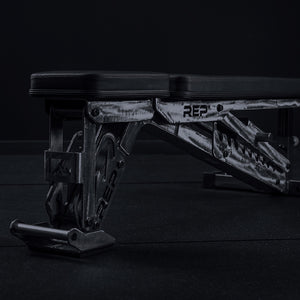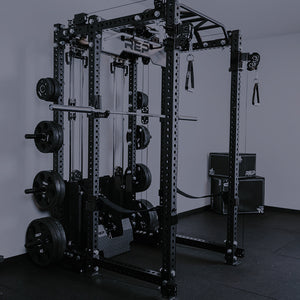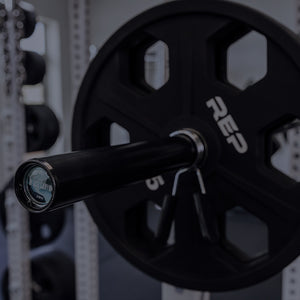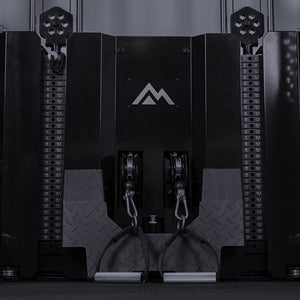
Safeties, first, kids.
While the Gym Bro Bible may proclaim to “live by the bar, die by the bar,” we don’t really want that, now do we? Preventing injury and staying safe is the real anabolic – the trick to getting those gains. Because you can’t keep growing if you’re stuck on the floor clutching your lower back.
Safeties, first, kids.
Especially if you’re lifting at home, make sure you invest in a quality pair of safeties for your power rack. There are three main types of safeties: pin-pipes, flip-downs, and straps. (Read allllll about them here.)
Let’s take a closer look at the latter – the benefits of those strappy guys, and why you might want to add a pair to your power rack.
Why Use Strap Safeties?

Strap safeties are:
1. Gentler on your barbell than metal, but they’re just as tough (heavy-duty bolts secure the straps to the bracket). This provides extra protection for your barbells, which you’ll definitely appreciate if you invest in a new, premium bar that costs a few hundred dollars.
2. Quieter (virtually noiseless). When the steel barbell contacts the nylon of a strap safety, it makes no clanking noise – which your neighbors and sleeping children at home might really appreciate.
3. Uniquely adjustable. The front and back ends can be mounted at different heights for the perfect positioning.
4. Super safe, thanks to the option to offset. Mount the brackets at different heights to allow the bar to roll safely away from you during a lift that was a little too heavy. For example, if you fail a squat, with offset safeties, the bar can roll away from your back and make it easier to get out from under the load. REP Strap Safeties can be offset by about five hole spaces, which means you can have one bracket set at hole #10 in the back and the other set at hole #5 in the front.
5. Easy to install on your rack. Simply attach them to your uprights like a J-cup and flip them securely into place.
6. Versatile in design. The original Strap Safeties come in three different strap lengths: 24”, 30”, and 41”. All lengths are about 3” wide. Strap Safeties 2.0 come in updated, shorter strap lengths to reduce the slack between the uprights. This makes it easier to set the proper height and bar position. The 2.0 straps for the 5000 Series are 3” wide, and they're 2" wide for the 1000 Series.
7. Versatile in function. In addition to catching your barbell if you miss a lift, they also provide extra exercise versatility like rack pulls and concentric exercises.
8. Smoother than metal. Placing the bar on nylon straps is way less jarring than placing it on metal. If you’re doing exercises like Pendlay rows, rack pulls, or pin squats/pin pulls from safeties, you might appreciate the gentler feeling of lowering the bar to the straps. The reps just aren’t as abrupt and might feel subtly easier on your joints.
9. Shock absorbent. The nylon of the straps absorbs the impact of the drop and spreads the force of a missed lift across the full length of the safeties. They also have a degree of stretch to them that metal safeties don’t have. While the metal safeties have the same weight capacity as the straps (700-1,000lbs, depending on the power rack series), you can lift in confidence knowing the strap safeties are shock absorbent.
10. Less distracting if your bar accidentally hits the safeties, especially when benching or squatting. It can be super disorienting (and even mess up a rep) if your metal bar hits a metal safety. No chance of that happening with nylon.
What are the Best Strap Safeties for Your Power Rack?

REP offers two types of strap safeties: the original Strap Safeties and Strap Safeties 2.0.
The original Strap Safeties are crafted from reinforced nylon, so they are easier on your barbell and just as durable as metal. They are secured with heavy-duty bolts to the bracket for reliable performance. Additionally, these Strap Safeties operate quietly, producing virtually no noise when they make contact with the barbell. Their unique adjustability allows you to mount the front and back ends at different heights for customized use.
Strap Safeties offer added protection during your exercises, particularly when working out solo or when attempting maximum lifts. They are easy to install—just attach the safeties to your uprights like a J-cup and flip them into place securely. Compatible with the PR-4000 and PR-5000 power racks, they are available in three strap lengths: 24", 30", and 41", with a strap width of about 3". These safeties are sold in pairs.

The Strap Safeties 2.0 offer all the same benefits as the original, but with an improved design. The patent-pending design secures brackets in place and prevents them from rotating when being pushed laterally. Updated, shorter strap lengths reduce the slack between the uprights. This makes it easier to set the proper height and bar position.
Straps for the 5000 Series are 3” wide, and they're 2" wide for the 1000 Series. Strap Safeties are also quiet; they’re virtually noiseless when they contact the barbell. The finish is more resistant to chips and scratches than ever before.
Difference Between Original Strap Safeties and Strap Safeties 2.0
Cosmetics: The 2.0 version has metallic black brackets versus the old matte black, black hardware, and black straps.
Functionality: The new bracket design has moved the pin position in line with the straps to prevent brackets from rotating when being pushed laterally. This ensures the brackets will not swing out of position on the upright. This also allows the straps to be positioned closer to the bottom of a J-cup, so they can still be used effectively with shorter ranges of motion.
Updated strap lengths allow for a tighter fit between uprights, causing less of a droop than the previous version.
Learn more about the Strap Safeties below.
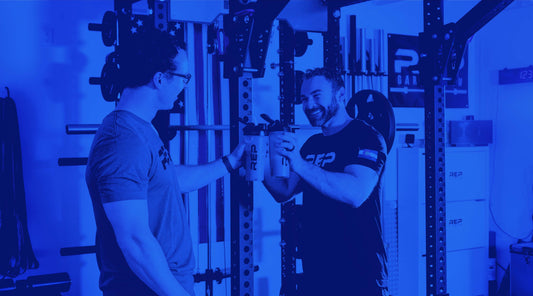
NEWSLETTER SIGNUP
Product launch information, promotions, blogs, and REP news.

